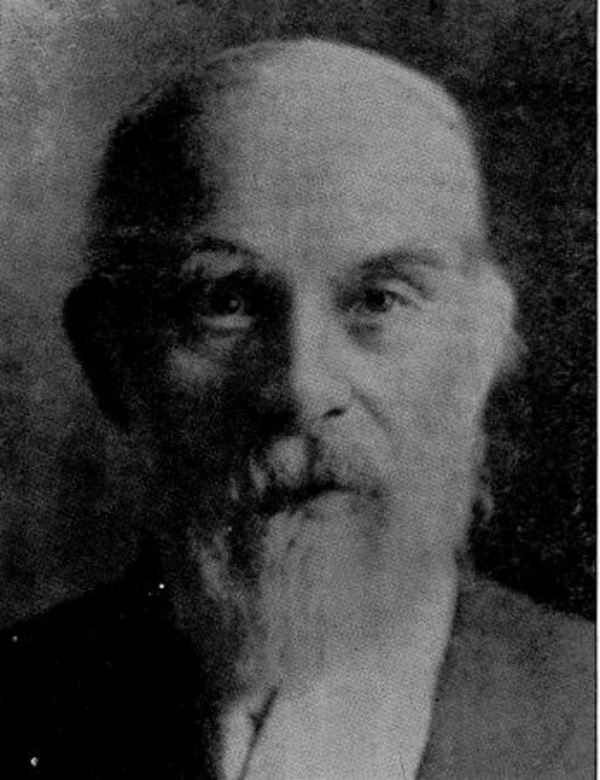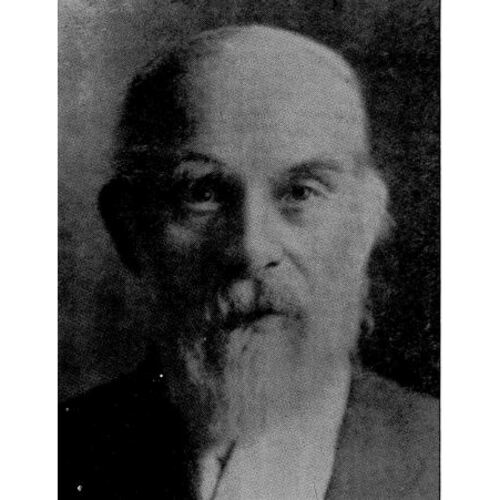
Source: Link
OULTON, ROBERT TRENHOLM, farmer and co-founder of the silver fox industry in Prince Edward Island; b. c. 1835 in Mount Pleasant (Little Shemogue), N.B., eldest child of Thomas Oulton and Catherine Taylor; d. 14 Feb. 1920 in Little Shemogue.
Robert Oulton grew up on the family farm in Mount Pleasant and attended the community’s school. On 15 July 1857 he married Jane Main in New Galloway (Galloway) and they had four children, including twin boys in February 1862. One of the twins died at birth and Jane shortly thereafter; the other twin was adopted by Jane’s sister. After his wife’s death, Robert moved with the two older boys to a 73-acre farm on Lot 17, P.E.I. In September 1862 he married Ann Brander of New London, with whom he was to have four daughters and six sons. They purchased the farm in 1866. In 1872 they bought land in what is now Brae Harbour, Lot 9, where they moved to escape the memory of the tragic accidental death the previous year of their son Robert. Robert Sr continued farming and also rafted lumber. In 1875 he became an elder in Lot 7 Presbyterian Church, where Brae Presbyterians were attending until the new Brae Presbyterian Church opened in 1879. Around 1880 the Oulton family moved to Savage Island, a 150-acre wooded island near Alberton which they rented from James Colledge Pope*. Oulton continued hunting and farming there and cleared 80 acres of virgin forest. In 1890 the family purchased the island, by then known as Cherry Island and today named Oultons Island.
While living in the Brae area, Charles Dalton* of Tignish had become a frequent hunting companion to Oulton. Of particular interest to the two was the elusive silver or black fox, a mutation of the common red fox. In the early 1880s Dalton began trying to breed silver foxes in captivity. Seeking Oulton’s expertise with wild animals, he proposed in 1894 that they form a partnership. The two men had clearly divided responsibilities: Dalton provided the first pair of foxes and Oulton supplied the land, labour, feed, and pens; Dalton handled all the business aspects of the operation and Oulton, the quieter and older of the two, cared for the foxes, checking on them several times daily. After experimenting with various designs, Oulton settled on a 2,500-square-foot wire pen which was large enough for the foxes to run in. It had an overhang slanted inward, which kept the foxes from climbing out, and walls which were buried one foot in soil, which prevented them from burrowing underneath. In 1894 the first litter was born. The prime foxes were nurtured and bred while the unhealthy ones were pelted and the skins sold. The first profit was realized in 1900 at a London auction house, C. M. Lampson and Company, where a single pelt fetched $1,807. For the duration of their partnership, Dalton-Oulton pelts received on average at least three times the price of other silver fox pelts sold at Lampson’s. The class-conscious English society provided a strong market for the Cherry Island farm.
Although Dalton and Oulton were secretive about their operation, even taking the precaution of shipping the pelts out of a small harbour at night, their neighbours James Gordon, Robert Tuplin, Silas Rayner, and Benjamin I. Rayner eventually discovered the lucrative business and asked to buy in. In 1900 the Big Six Combine was formed with the agreement that no live foxes would be sold. This monopoly was broken in 1910 when Frank F. Tuplin, Robert Tuplin’s nephew, sold a pair of live foxes for $5,000.
By 1913, with 3,130 foxes of all grades on 277 ranches, the fox industry was flourishing. That year, according to the report of the commissioner of agriculture, the value of silver foxes alone was estimated to be almost 14 million dollars. By 1924 there were about 600 large and small ranches and an additional 100–200 farmers owning between one to three pairs of foxes. Small-scale breeders sold independently or through the Silver Black Fox Breeders’ Association of Prince Edward Island, founded in 1913, and from the 1920s through the Canadian National Silver Fox Breeders’ Association and the Prince Edward Island Fur Pool Limited. In 1924 B. I. Rayner received the highest recorded sum, $32,500, for a live pair of foxes. The highest price received for a single pelt was $2,600, in 1934. The large infusion of cash into the Island economy saw many homes built, automobiles purchased, children educated, and charitable donations made.
Silver fox pelts were most popularly worn by women as a decorative collar. A single pelt was draped over the shoulder with the snout fastening to the hind of the pelt and the white-tipped tail hanging down the back. By the late 1920s capes made of several matched pelts were also fashionable. The industry began to wane in the 1930s for several reasons, including changes in fashion, the increased availability of warm and decorative materials, the worldwide depression, and a larger supply of pelts provided particularly by Scandinavian countries.
As had been stipulated in the initial agreement between Dalton and Oulton, a few years after the Cherry Island ranch achieved success, Dalton moved some of the foxes to his own farm in Tignish. Dalton and Oulton discontinued their partnership in 1912. The previous year Oulton and his wife had moved to Little Shemogue, where they built a home that was a duplicate of their home on Cherry Island. Oulton took four pairs of foxes with him to New Brunswick and divided the rest among his sons. Despite the high quality of Oulton’s foxes, the Silver Black Fox Breeders’ Association refused to give a grade A rating to their offspring because they were not born on the Island. Oulton was disappointed and in 1914 sold all the foxes belonging to him and his family in Little Shemogue, to the Saint John firm of Kierstead and Mersereau for $224,000.
During his retirement, Oulton donated the cost of renovations and a bell at Zion Presbyterian Church in Little Shemogue. Ann Brander Oulton died in 1918 and Robert in 1920. Having pioneered the breeding of silver foxes in captivity, Robert Oulton was almost solely responsible for the success of the industry, but he died before its busy moneymaking days in the 1920s. Although many people became wealthy because of his skill, Oulton had only $10,000 at the time of his death.
Alberton Museum (Alberton, P.E.I.), Eileen Oulton, “Robert Trenholm Oulton.” PARO, Acc. 2860, esp. items 8 (A. M. Behling, Robert T. Oulton, the founder of Canada’s black fox industry, Saint John, n.d.) and 9 (Eileen Oulton, Notes and observations on the development of the silver fox industry, photocopy, 1975). Charlottetown Guardian, 22 April 1913. Can., Dominion Bureau of Statistics, Report on the fur farms of Canada (Ottawa), 1934. J. W. Jones, Fur-farming in Canada (Montreal, 1913). Heidi MacDonald, “The significance of the silver fox industry on western Prince Edward Island” (ba thesis, Mount St Vincent Univ., Halifax, 1990). D. A. MacKinnon, “Fox boom on Prince Edward Island,” Silver Fox Breeder (Boston), 1 (1924–25), no.2: 25 (copy in PARO, Acc. 2671). P.E.I., Dept. of Agriculture, Annual report (Charlottetown), 1913, report of the commissioner of agriculture; Extracts from reports on fur farming by dominion government officials, commissioner of agriculture for Prince Edward Island, American consul at Charlottetown (Charlottetown, 1914; copy in PARO, Acc. 2671). R. A. Rankin, “Robert T. Oulton and the golden pelt,” Island Magazine (Charlottetown), no.3 (fall/winter 1977): 17–22. F. F. Tuplin, Origin of silver foxes on P.E. Island in 1887 (n.p., n.d.). Year book: province of Prince Edward Island, 1913 (Charlottetown, 1913).
Cite This Article
Heidi MacDonald, “OULTON, ROBERT TRENHOLM,” in Dictionary of Canadian Biography, vol. 14, University of Toronto/Université Laval, 2003–, accessed December 12, 2025, https://www.biographi.ca/en/bio/oulton_robert_trenholm_14E.html.
The citation above shows the format for footnotes and endnotes according to the Chicago manual of style (16th edition). Information to be used in other citation formats:
| Permalink: | https://www.biographi.ca/en/bio/oulton_robert_trenholm_14E.html |
| Author of Article: | Heidi MacDonald |
| Title of Article: | OULTON, ROBERT TRENHOLM |
| Publication Name: | Dictionary of Canadian Biography, vol. 14 |
| Publisher: | University of Toronto/Université Laval |
| Year of publication: | 1998 |
| Year of revision: | 1998 |
| Access Date: | December 12, 2025 |



